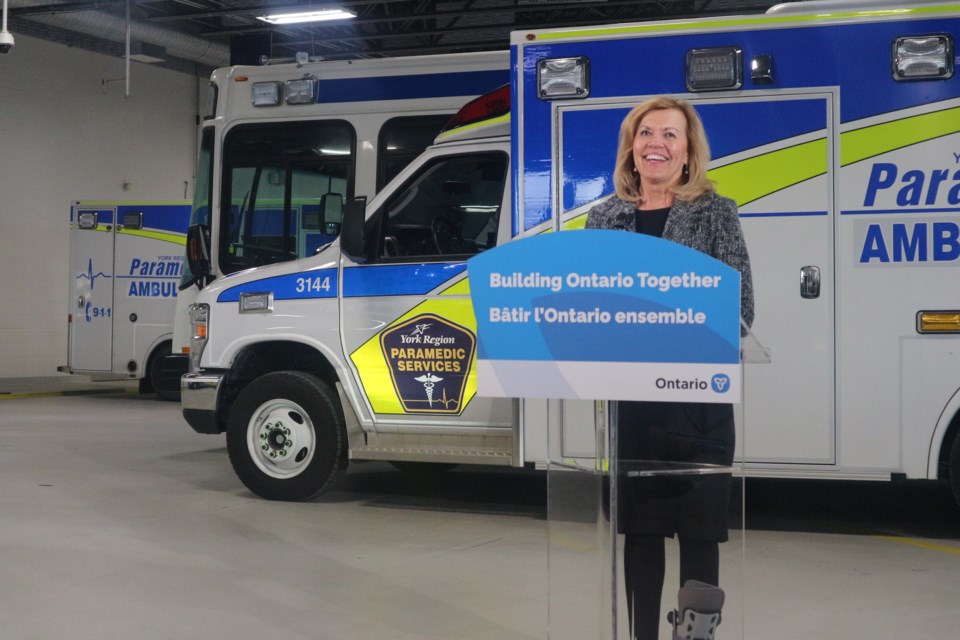The Southlake Community Ontario Health Team is among the first of 24 teams in the province that will implement the government’s new plan for a sustainable health care system built around patient needs, Deputy Premier and Minister of Health Christine Elliott annouced this afternoon at the York Region Paramedic Services Headquarters in East Gwillimbury.
Ontario Health Teams are the new model of care being rolled out, which brings health care workers and community partners together to work on one team.
“Care providers from every stage of a person’s health care journey are coming together as a single team to provide that patient-centric care that we want so badly in Ontario,” said Elliott.
She noted how Ontario has some of the “finest health care professionals in the world”, but acknowledged the current system is under a lot of pressure with patients and families “getting lost in the system", "falling through the cracks" and "waiting too long to be able to access the care that they need.”
The integrated health care system will be a better way for patients and their families to better connect with health care providers and services in their community, she said.
“Our government has made a commitment to Ontarians to build a sustainable and connected public health care system focused on the needs of patients and ending hallway health care,” said Elliott.
Through the Ontario Health Team program, patients will be better able to transition from one provider to another, with one patient record and care plan.
The work behind the plan will be implemented in phases, with a long-term goal of supporting patients with complex medical or social needs.
In the first year, the Southlake team will focus on supporting older adults with complex care needs and adults with mental health and addictions challenges.
"Over time, (they) will provide care for everyone within the Southlake Community Ontario Health Team’s population,” she added.
There are already great examples of community providers coming together to help with patient centric care, Elliott said, pointing to Southlake at Home, one of her “favourite provider programs” that gives patients an intensive transitional care plan to ensure their safe return home from hospital.
Each team will be responsible for delivering care to patients and knowing their health care history, while being able to connect them to different types of care they need.
The first wave of Ontario Health Teams is being approved after a thorough and extensive assessment process, which involved much time and research among many partners in the health care sector, Elliott said.
“We are excited to be one of a handful of Ontario Health Teams working with RNAO to help spread evidence-based best practices even further across our partnership,” said Arden Krystal, Southlake Community Ontario Health Team planning committee co-chair and president and CEO of Southlake Regional Health Centre.
“It is great news for all of us and I have to say that the Southlake Community Ontario Health Team represents the best of what our healthcare providers have to offer,” said Elliott.
“The team will take the guesswork out of navigating the health care system and will improve access to secure digital health tools, including online health records and virtual health care options. It will also work to reduce clinician burnout and lay the foundation for a sustainable future.”
The Southlake Community Health Team plans to implement some of the proposed programs in 2020.
Dr. David Makary, chief of family and community medicine at Southlake and family physician at Southlake Academic Family Health Team, said he is honoured to be the primary care lead of the program representing more than 150 family physicians and nurse practitioners who have helped to build and design the Southlake Community Health Team.
“For an Ontario Health Team to be successful, system coordination needs to be rooted in primary care and the Southlake Community OH Team we are building on insights from leading international health care systems in order to jump from distant silos to truly connected care,” he said.
Elliott noted with hospitals operating over capacity, Ontario also has an extensive plan to end hallway health care, and will include investments and initiatives in the following four pillars:
- Prevention and health promotion: keeping patients as healthy as possible in their communities and out of hospitals.
- Providing the right care in the right place: when patients need care, ensure that they receive it in the most appropriate setting, not always the hospital.
- Integration and improved patient flow: better integrate care providers to ensure patients spend less time waiting in hospitals when they are ready to be discharged. Ontario Health Teams will play a critical role in connecting care providers and, in doing so, helping to end hallway health care.
- Building capacity: build new hospital and long-term care beds while increasing community-based services across Ontario.
"I know that all of us working together we will be able to create a truly patient centric system of care for all Ontarians so that they can receive the care that they need at the right place so thank you Southlake Community Health Team for the great work you are doing," said Elliott.
